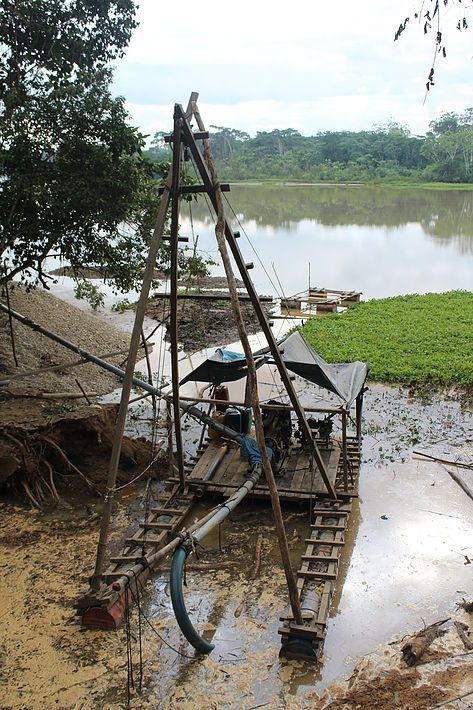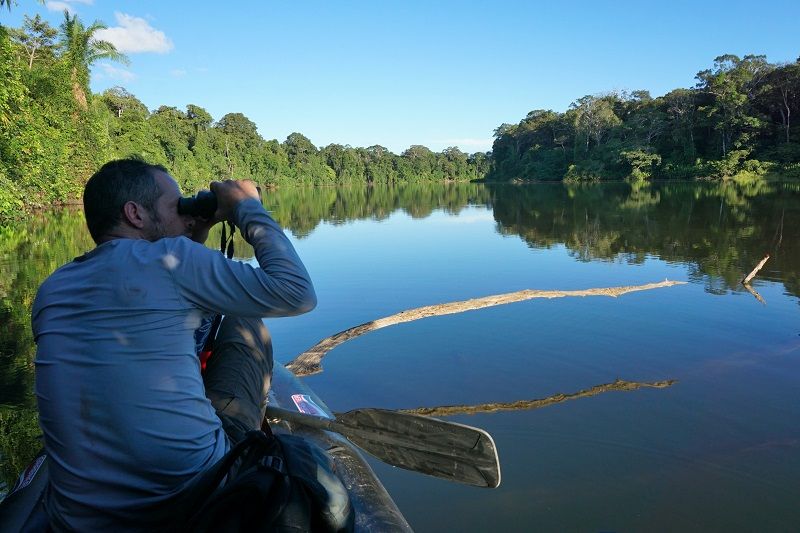Consequences of deforestation and mining
Deep in the heart of the Amazon rainforest our Conservation Partner, Adi Barocas, is busy trying to understand how gold mining is impacting one of the jungle’s largest predators: the giant otter, or river wolf (‘lobos de rio’), as they are known locally. Artisanal small-scale mining, informal digging often carried out by individuals predominantly in Africa and South America, uses basic technologies but often with severe consequences. On the one hand it offers individuals a chance to earn money where options are limited. However, as well as being hotbeds for labour abuses, organised crime and prostitution, many methods used in small-scale mining are also highly damaging to wildlife and ecosystems. Most notably the use of mercury and cyanide, used to extract and process the gold, with dire repercussions for the environment and communities that live nearby.
Yet, sadly, damage to habitats and wildlife isn’t just through mercury and cyanide poisoning. Deforestation occurs as miners create access points to get their equipment in and out.
The use of high-pressure water jets to wash the soil leads to erosion and extensive damage of waterway banksides. And, as the soil is washed, large amounts of sediments are swept into the water where they can remain suspended, changing the quality and transparency of the water, which impacts the species living there.
Oxbow lakes and otters
Adi’s study site in Peru, in the Madre de Dios province, covers a stretch of river that lies within Manu National Park and another section that falls outside the protected area. Focusing on oxbow lakes – shallow, elongated waterbodies that dot the Amazon’s floodplains – he has been assessing whether there’s a difference between lakes within a protected area and those downstream that are subject to mining pressures. Oxbow lakes are formed as meandering rivers form ever-increasing loops until, often during a flood, the river cuts through the neck and continues on the straighter option. In many areas these lakes eventually dry up. Within Madre de Dios, annual flooding keeps these lakes functioning despite some of the lakes being almost 3km from the river. But flooding also exposes the lakes to effects of nearby human activities.
Upstream in Manu National Park and downstream outside the park, Adi’s been comparing various factors to see which are most likely to impact fish abundance and diversity. Vegetation type and water quality, including oxygen levels and transparency were compared. Natural variables such as the size or elevation of each lake were taken into account, as well as human-induced factors including those indicative of mining intensity such as the proximity of deforested areas. Intensity of fishing was also considered, by assessing the signs or presence of fishing vessels in each area. Giant otter occurrence and numbers were also examined, since the presence of these top predators might also affect fish abundance.
Fish communities are impacted by mining
Adi’s results indicate that there is a decrease in the richness of fish species in the disturbed lakes, predominantly because of high levels of fishing and a decrease in water transparency – reflecting water quality and the amount of suspended material in the lakes. He found fewer carnivorous fish species and more detritivores – animals that feed on dead organic material. Fish assemblages in unprotected lakes also had significantly fewer fish both in terms of numbers and overall biomass. That means that the entire fish communities of these lakes are being impacted. Fishing both for subsistence and commercial practices were documented in all but one of these lakes. It appears that not only does mining itself impact the water quality, but the people drawn to the area by mining activities drive a heavier fishing toll, as workers and their families need local sources of food to sustain them.
Adi’s study was carried out in the dry season, when the lakes were cut-off from the main Madre de Dios river. He speculates it’s likely that some of the negative impacts caused by mining and fishing are mitigated when the river floods in the wet season and replenishes the lakes. The good news is that the protected status seems to be working for fish and the predators that rely on them within Manu national park. But fishing also takes place in these areas, so Adi’s findings could help provide guidance on the level of fishing that’s sustainable in the more vulnerable lakes in these areas.

Human activities impact the survival of giant otters
Giant otters are an endangered species, still recovering from past population declines because of hunting. For this top predator, this research provides crucial information related to the quantities of medium and large fish, the main food it relies on, which are likely to influence its ability to survive. Understanding how human activities influence the integrity of freshwater ecosystems in tropical areas such as the Madre de Dios basin is also an important step towards securing the conservation of these vulnerable habitats.
Thank you for helping us fund this research to protect giant otters in Peru.
If you’d like to support this work, please donate or set up a direct debit here today.
Find out more about our work to protect giant otters in Peru:


